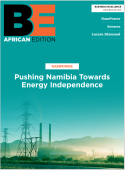Gold fever
Dan Bailey discovers a raised temperature, if not exactly a raging fever, associated with a new gold exploration program in South Africa.
The lure of gold has always led men to take chances. In the 1840s and 1850s, countless individuals uprooted themselves and travelled half the world for the gold fields of America and Australia. These days there is still an element of risk involved; the difference being that the risks are financial, investing huge sums in companies that might just hit the mother lode.
The Witwatersrand Basin in South Africa, stretching from east of Johannesburg in the Transvaal down through the Orange Free State has, for decades, been the core of gold production. California might have had the romance but over the years, but South Africa has produced the most gold; a third of all the gold ever minedÔÇö1.5 billion ouncesÔÇöhas come from this area.
But it hasnÔÇÖt come easily. Most of South AfricaÔÇÖs gold is deep underground, often several thousands of meters. Broadly speaking, one ounce of gold is extracted from a ton of mineral bearing rock, so compared with CaliforniaÔÇÖs prospectors, the job has been much harder.
Yet although the general trend for extraction activity in the Wits basin is down, there are still some willing to invest millions in the belief that there is still enough gold to be found to make a modern day fortune. Wits Gold, for example, has raised $26 million since its inception in 2003 from private investments, largely from institutional shareholders. Three years later it gained listing on the Johannesburg stock exchange while just last year it announced shares would be traded on the Toronto stock exchange, opening shareholding further to North American investors. At the end of April 2008, Wits GoldÔÇÖs market capitalization was US$446 million and it had working capital of US$18 million.
For what did Wits Gold want this money? In 2003, chairman Adam Fleming identified land holdings located adjacent to many existing productive gold mines that were sitting dormant. Given that rival companies would hardly exchange geological data, these properties seemed unattractive as single stand alone projects. Fleming speculated that there was untapped potential there and saw the possibility of consolidating and combining the disparate properties in order to capitalize on this potential.
Fleming and CEO Marc Watchorn approached the owners and succeeded in putting together a significant portfolio of assets in selected areas of the Wits Basin, complete with all historical exploration data on the properties based on 203 boreholes containing 526 kilometres of drill core and 2,882 intersections of the Witwatersrand reefs. Had this task of drilling and gathering the dataÔÇönow stored in a 6000m2 warehouseÔÇöbeen undertaken today, it would have taken 10 years and cost $100 million.
Utilizing a team of geologists with extensive experience within the Wits Basin and a fresh approach, Wits Gold set about re-evaluating the geology of the properties through the examination of existing core, construction of appropriate geological modelling and further drilling to advance new interpretations. Most interestingly the properties acquired do not represent any major breakthrough in terms of exploration but rather a fresh look at the assets with the benefit of all the historic exploration and core data made available to one company. The historical data has enhanced Wits GoldÔÇÖs ability to re-interpret the information on the properties and derive better and or improved geological models.
Conscious of not wanting to give away valuable assets, once the bankable feasibility stage has been reached, vendors will have a one-off opportunity to purchase a 40 percent interest in the future mining venture. Should the vendor waive that opportunity and Wits Gold then elects to sell on the rights to those minerals, the agreement provides vendors a 50 percent share of proceeds, less a three times multiple of the exploration costs incurred by Wits Gold.
Independent consultants have estimated indicated resources of 19.4 million ounces of gold, in addition to inferred resources of 130.4 million ounces and 54.3 million pounds of uranium. Drilling is ongoing at four of the most advanced prospects (Bloemhoek, De Bron, Kromdraai and Kleinfontein) and results at Bloemhoek and De Bron have delineated a resource capable of supporting a standalone mine for some 25 years or longer depending on the configuration used to access and exploit the ore body. Although some of the gold is at 6000m, Wits is focusing on reserves lying between 400 and 2500 metres.
The Bloemhoek project is a relatively shallow, typical Witwatersrand gold project which has gold bearing reefs from 1,300m to 2,500m below surface. When compared to recent expansion projects within the SA gold mining industry, this is shallow. For example, AngloGold AshantiÔÇÖs Moab is 3,800m below surface while Gold FieldsÔÇÖ South Deep is over 2,800m below surface. As alternative development sites are already on stream or will be in the near future, Wits Gold believes that its two properties at Bloemhoek and De Bron are likely to be the next large South African gold mine developments.
As with many other companies, Wits Gold is participating in the governmentÔÇÖs Black Economic Empowerment (BEE) program. Two major shareholding groups, representing Historically Disadvantaged South Africans hold approximately 32 percent of stock. In addition, the Wits Gold Women's Trust has been established with five percent of the companyÔÇÖs initial equity and registered as a new charitable organization with the aim of developing opportunities for South African women within the mining industry. R2.3million has been committed to fund a number of bursaries to deserving candidates and cover their further education for a four year period.
With exploration and mining less vibrant than in the past, there is a growing pool of skilled and non-skilled mine workers looking for employment. If all goes to plan, HDSA representatives will no doubt be pleased that black South Africans could soon be employed there while Wits Gold will be relieved that experienced teams of development engineers will also be on the job market.









